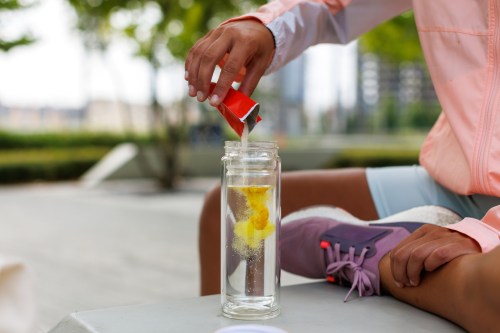Ripe Versus Unripe Fruits and Vegetables Offer Very Different Health Benefits—Here’s How They Compare
Ripe vs. unripe fruit and vegetables differ in terms of health benefits and nutrients. Here's how, according to an RD.

There’s no doubt that fruit and veggies are always good for us. From antioxidants and fiber and a host of vitamins and minerals in between, getting in your daily dose of produce is always a smart choice. But did you know that for many fruits and vegetables, how ripe they are can have an impact on which health benefits they offer?
Experts in This Article
registered dietitian and founder of Halve Your Cake
Chances are, when you’re at the market choosing your bananas, peppers, and tomatoes, you’re looking for something that is at its peak ripeness, most vibrant color, and will offer the max value of natural sweetness and flavor. And while there is always a time and place for the perfectly soft avocado (ahem, here’s how to ripen avocados effectively) or creamy banana, it can be helpful to know the full range of possibilities to maximize your health and enjoyment.
Before we dive in, it is important to keep in mind that regardless of ripeness, all forms of fruits and vegetables have a place in a healthy, well-balanced meal regime. “Try not to get too hung up on the benefits of one over the other, but rather focus on eating a varied diet full of fruits, vegetables, healthy fats and whole grains,” cautions Kathleen Fracaso, RD.
With that said, keep reading to learn how the level of ripeness affects some of the healthful qualities of the produce we know and love. At the very least, you might just get some inspiration for those green tomatoes that come in your CSA box or the unripe bananas sitting on your kitchen counter.
The health benefits of ripe vs. unripe fruit and vegetables
1. The sugar and starch content of ripe vs. unripe fruit differs greatly.
Once a fruit or vegetable reaches its full size, the ripening process begins. So, what exactly is happening at this point? Starch is being converted to sugar, pigments (also known as phenolic compounds) develop, and texture begins to soften as pectin converts from water-insoluble to soluble. All of this results in the mature, sweet, and flavor-filled produce we know and love.
“At the start of this process, the levels of resistant starch in a piece of produce are high and are reduced as starches are converted into sugars,” says Fracaso. “Resistant starch cannot be digested or broken down by enzymes in the mouth, stomach, or small intestine, so it passes into the large intestine to be fermented by gut microbiota. Resistant starch is essentially the ‘food’ the microbes in our gut need to survive.”
Fracaso explains that when a simple sugar is consumed on its own, it is easily broken down. It passes quickly into the bloodstream, resulting in an all-too-familiar blood sugar spike and drop roller coaster and quick reappearance of hunger. “Alternatively, when those same sugars are consumed in conjunction with resistant starch and/or fiber, the nutrients pass more slowly through the digestive tract, resulting in a more gradual release of glucose—aka sugar—into the bloodstream and increased satiety, or feelings of fullness,” she explains. A benefit of slower absorption is that since the food is passing more slowly through the digestive tract, the body is able to pull out even more vitamins and nutrients, giving you more nutritional bang for your buck.
Let’s put this in context with one of the most consumed fruits out there: The banana. Unripe bananas (also known as green bananas) are higher in resistant starch and lower in sugar. When that banana ripens, the resistant starch gets converted into sugar, flipping the ratio. “Consuming an unripe banana will result in a slower, more regulated release of sugar into the bloodstream, whereas consuming a ripe banana will cause blood sugar to spike more quickly,” explains Fracaso. She is quick to add, however, that even ripest banana would lead to a far more gradual blood sugar spike than candy or soda due to the fiber that remains in the ripe version of the fruit.
One thing to look out for when eating raw bananas (and other foods high in resistant starches, such as raw potatoes and beans) are potential digestive woes. According to Fracaso, since resistant starch travels all the way to your large intestine before it can be digested, it is possible that if your system is not used to consuming that type of starch and amount of fiber. If you have a sensitive stomach, start slowly and allow your system to adjust if you experience discomfort. Try gradually adding in more fiber and foods filled with resistant starch to get the ultimate health payoff, sans indigestion.
2. Antioxidant values typically increase as fruits ripen.
“While the conversion of starch to sugar is the most notable change during the ripening process, vitamins, minerals, and antioxidants also develop and convert as fruit ripens,” says Fracaso. Antioxidants in particular have been shown to increase during the ripening process. Anthocyanin, which is the antioxidant compound that gives fruit and vegetables their deep purple color, has been shown to increase more than fourfold in studies of blackberries as they transition from underripe to ripe.
Luckily, we tend to be drawn to antioxidant-rich fruits when they are at their peak ripeness (and therefore sweetness), so you are likely already reaping this health benefit without much effort beyond your normal enjoyment of nature’s candy.
3. Vitamin C content increases or decreases, depending on the type of produce.
“Vitamin C has also been shown to increase in bell peppers, tomatoes, and pineapple as ripening occurs,” says Fracaso. In oranges, grapes, and lemons however, vitamin C content is actually at its highest when the fruit is half ripe. Vitamin C can help support a healthy immune system, protect against free radicals, help speed up the body’s natural healing process, and even assist with the ability to absorb iron effectively.
How to use unripe fruit and veggies
Looking for inspiration on how to begin to incorporate fruits with varying stages of ripeness into your diet? Green bananas are best when eaten raw, as the baking process benefits from the higher sugar content (and softer texture) of ripe bananas. Try slicing them as a topper for oatmeal or greek yogurt, or making this vibrant and insanely delicious creamy banana puree with poached eggs and herbs (aka cayeye con huevo y hierbas), which benefits from the slight crunch of green bananas.
“One of my favorite ways to enjoy both ripe and unripe bananas is in nice cream,” says Fracaso. “I like to mix both green and yellowish-brown banana slices together and freeze them before blending them to make vegan ice cream the next day. What’s so fun about this recipe is the flavor possibilities are endless! I personally love adding a scoop of chunky peanut butter and some unsweetened mini chocolate chips. Such a fun and delicious dessert, snack, or even breakfast.”
Thinking beyond the banana, green tomatoes can be fried or made into a salsa verde, unripe strawberries can be combined with ripe ones for unexpected depth in a fruit salad, and green plums can be pickled and used to top lamb or fish.
With a little creativity, there is plenty of room for all stages of ripeness in the kitchen—just make sure you’re starting with good quality produce for optimal flavor.
Oh hi! You look like someone who loves free workouts, discounts for cutting-edge wellness brands, and exclusive Well+Good content. Sign up for Well+, our online community of wellness insiders, and unlock your rewards instantly.










